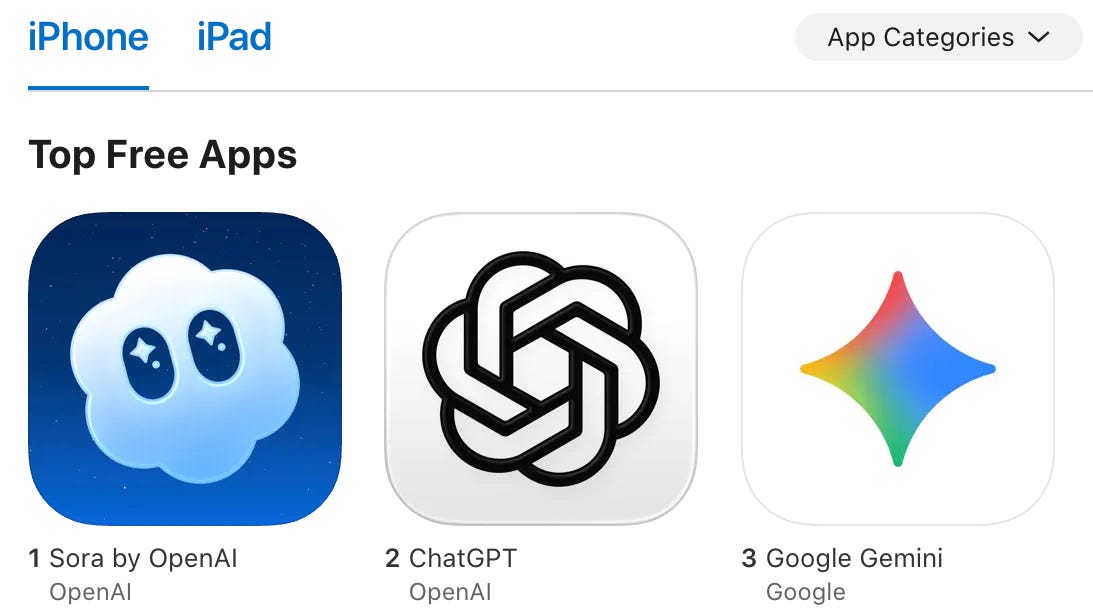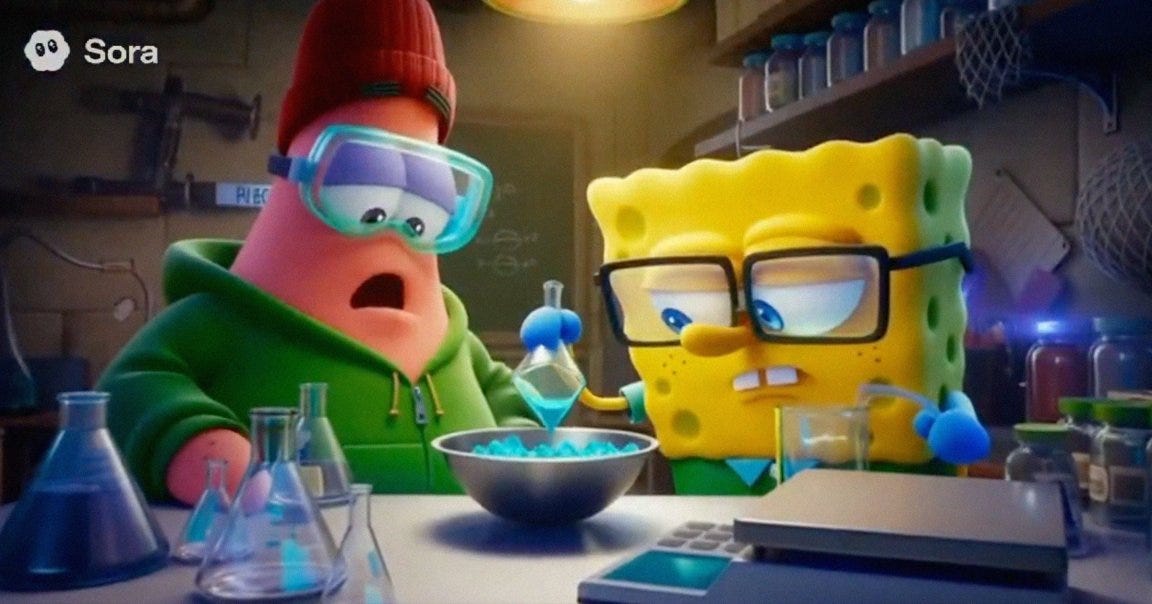Sora 2 Trained On Everything (And Hollywood Is Furious)
Here's why $20B in market value vanished, what Meta missed, and the three challenges that could kill this before it scales.
Last Tuesday, OpenAI did something nobody expected.
They didn’t just launch Sora 2, their next-generation video model. They launched a full social platform, an AI-native TikTok competitor that hit #1 on the App Store within hours.
Wall Street’s response? They wiped $20 billion off social media stocks.
I got early access and spent the last few days inside the app. What I found is either the future of social media or OpenAI’s most expensive mistake.
Watch my full breakdown here, where I go deep on the interface, show live demos of the remixing features, explain the copyright controversy in detail, and break down exactly why $20B in market value disappeared overnight.
YouTube Chapter Links:
00:00 Introduction
00:50 What Is Sora 2?
02:14 The Cameos Feature That Changes Everything
02:30 How It Actually Works
06:13 Safety Features: Identity Verification & Consent
07:03 Meta’s Vibes vs Sora 2
09:02 Why Sora 2 Crushes The Competition
09:43 OpenAI’s War With Hollywood
11:32 The AI Slop Apocalypse
12:46 OpenAI’s “Feed Philosophy”
15:47 The Market Reaction: Who’s Most Vulnerable
16:57 The TikTok Ban Factor
17:34 My Prediction: What Happens Next
Here’s what makes Sora 2 different:
This isn’t another AI tool. It’s a vertical-scroll, algorithmic social feed that looks exactly like TikTok, except everything is AI-generated, and the killer feature is social remixing with your actual face and voice.
You record a short verification clip, set permissions (only you, mutuals, everyone, or specific people), and suddenly you can drop yourself into any AI-generated video. Your friends can do the same with you.
The result? Your social graph manifested as videos doing impossible things.
I made my friend contemplate if we’re living in a simulation. I asked what would happen if Sam Altman turned on the AC for the first time. I had Rick and Morty explain 3D Gaussian splatting to me.
Every time someone uses your likeness, even in their drafts, you get notified. Don’t like it? Delete it instantly.
What Meta, Google, and TikTok missed:
OpenAI nailed three things simultaneously that no one else managed:
Consumer-first interface (like Meta’s Vibes attempt, but actually good)
Production-grade output (Google Veo 3 quality)
Social collaboration built in (made to create WITH friends, not just for them)
Meta released “Vibes” literally one week before Sora 2 launched. TechCrunch called it “mindless slop.” They tried to get to market first but shipped something half-baked.
Google is taking Veo 3 quality and adding it as a feature inside YouTube Short, but it’s additive to existing video creation, not the main course.
OpenAI built the whole restaurant.
The copyright war that’s brewing:
Here’s where things get controversial.
OpenAI is using an opt-out model for copyrighted content. Unless studios, agencies, and creators actively tell them “don’t use our IP,” Sora 2 can generate videos referencing anything.
And here’s the kicker: OpenAI won’t accept blanket opt-outs. If you own 100 franchises, you have to monitor and report violations individually.
Right now, you can generate yourself as Marvel superheroes, Master Chief, Simpsons characters, Lord of the Rings wizards, basically any IP you want.
Hollywood Reporter called this “the most aggressive AI move in history.”
The lawsuits are coming.
The three challenges that could kill this:
Challenge #1: The Copyright War
Studios aren’t going to let this slide. OpenAI is essentially saying “we’ll train on everything unless you painstakingly tell us what not to train on.” This will end up in court, and the outcome could force major changes to how the platform works.
Sam Altman’s “grand plan” to take down Hollywood
Challenge #2: The AI Slop Dilemma
Lower the barrier to creation, and everyone can create. The harsh truth? Most people aren’t creative. We’ve already seen this with SEO slop flooding Google, robo-generated YouTube videos, and those weird “Shrimp Jesus” creations on Facebook.
Quality content will get drowned out by algorithmic similarity. OpenAI published a “Sora Feed Philosophy” promising to optimize for creativity over engagement, but we’ll see if that holds when monetization pressure builds.
Challenge #3: Changing Behavior at Scale
TikTok has 150 million US users. Instagram Reels is even bigger. YouTube Shorts gets billions of views daily.
ChatGPT changed search behavior by adding something new. Sora 2 is asking people to replace something they already love, apps they use every single day.
Even with superior technology and innovative features, getting people to switch platforms is incredibly hard.
Why the timing matters:
TikTok is facing regulatory scrutiny in the US and Europe. If TikTok gets restricted or banned, where do those 150 million US users go?
Instagram Reels? YouTube Shorts? Or maybe an AI-native platform built by an American company that feels like TikTok?
OpenAI is positioning itself for that moment.
What happens next:
Right now, Sora 2 is invite-only on iOS in the US and Canada. Android and broader access are coming soon. Within weeks, we’ll see API access for third-party developers.
That means Sora 2 will integrate into video editing platforms, marketing tools, game development, Adobe Firefly, Canva, all of them.
But make no mistake: this isn’t a sideshow. This is the next platform war playing out in real time.
My take:
I’ve been creating content with Sora 2 for days now, and the social remixing feature is genuinely addictive. The ability to instantly drop yourself or friends into any scenario, then have them iterate on it, that’s never existed before at this quality level.
But the copyright situation is unsustainable. The AI slop problem is real. And changing user behavior away from TikTok is a generational challenge.
OpenAI is betting they can solve all three fast enough to capture the moment.
The future of social media might be AI-native. Or this might be the most expensive experiment in tech history.
Either way, we’re about to find out.
Check out some recent discussion over on X about Sora 2:
If this gave you something to think about, share it with fellow reality mappers. The future’s too interesting to navigate alone.
Cheers,
Bilawal Sidhu
https://bilawal.ai



